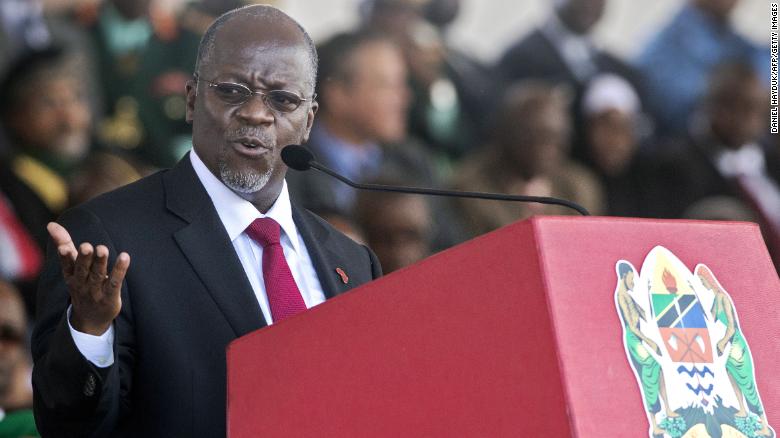Mwingereza
JF-Expert Member
- Jan 21, 2014
- 1,110
- 2,736
Rais wetu Mpendwa Dr. Pombe on CNN tena kwa mabaya. Tumekuwa kichecho cha Dunia. Tena Front Page
'Don't use birth control,' Tanzania's President tells women in the country
'Don't use birth control,' Tanzania's President tells women in the country

Tanzanian President John Magufuli urges citizens to keep reproducing
(CNN)Tanzania's President John Magufuli has told women in the East African nation to stop taking birth control pills because the country needs more people, according to local media reports.
"Women can now give up contraceptive methods," Magufuli said.
"Those going for family planning are lazy ... they are afraid they will not be able to feed their children. They do not want to work hard to feed a large family and that is why they opt for birth controls and end up with one or two children only," he said at a public rally on Sunday.
He was quoted in a local newspaper, The Citizen, as saying that those advocating for birth control were foreign and had sinister motives.
Magufuli urged citizens to keep reproducing as the government was investing in maternal health and opening new district hospitals.
The United Nations Population Fund (UNFPA) representative for Tanzania, Jacqueline Mahon, was present when Magufuli made his comments, reports said.
CNN has reached out to the UNFPA for comment but did not immediately receive a response.
"I have traveled to Europe and I have seen the effects of birth control. In some countries they are now struggling with declining population. They have no labor force," the Citizen newspaper quoted him as saying.
Follow CNN Africa on social media
Read the latest news from Africa and share your thoughts with us on Facebook, Twitter and Instagram
Tanzania's population is around 53 million people, and 70% of them living on less than $2 a day, according to a 2015 World Bank report.
"You have cattle. You are big farmers. You can feed your children. Why then resort to birth control?" he asked. "This is my opinion, I see no reason to control births in Tanzania," Magufuli, who has two children, said.
Opposition MP Cecil Mwambe criticized the President's comments, saying they were against the country's health policy.
President Magufuli is known as 'The Bulldozer' for his tough stance against corruption and his hardline policies, which include denying education to schoolgirls who become pregnant.
In another development, the speaker of the Tanzanian parliament banned female lawmakers from wearing fake nails and eyelashes in parliament.
"With the powers vested in me by the Constitution of the United Republic of Tanzania, I now ban all MPs with false eyelashes and false finger nails from stepping into Parliament," Job Ndugai said, a day after Magufuli's comments.
The new rules also ban women MPs from wearing short dresses and jeans. Female visitors to parliament are also expected to adhere to the dress code.
'Don't use birth control,' Tanzania's President tells women in the country
'Don't use birth control,' Tanzania's President tells women in the country

Tanzanian President John Magufuli urges citizens to keep reproducing
(CNN)Tanzania's President John Magufuli has told women in the East African nation to stop taking birth control pills because the country needs more people, according to local media reports.
"Women can now give up contraceptive methods," Magufuli said.
"Those going for family planning are lazy ... they are afraid they will not be able to feed their children. They do not want to work hard to feed a large family and that is why they opt for birth controls and end up with one or two children only," he said at a public rally on Sunday.
He was quoted in a local newspaper, The Citizen, as saying that those advocating for birth control were foreign and had sinister motives.
Magufuli urged citizens to keep reproducing as the government was investing in maternal health and opening new district hospitals.
The United Nations Population Fund (UNFPA) representative for Tanzania, Jacqueline Mahon, was present when Magufuli made his comments, reports said.
CNN has reached out to the UNFPA for comment but did not immediately receive a response.
"I have traveled to Europe and I have seen the effects of birth control. In some countries they are now struggling with declining population. They have no labor force," the Citizen newspaper quoted him as saying.
Follow CNN Africa on social media
Read the latest news from Africa and share your thoughts with us on Facebook, Twitter and Instagram
Tanzania's population is around 53 million people, and 70% of them living on less than $2 a day, according to a 2015 World Bank report.
"You have cattle. You are big farmers. You can feed your children. Why then resort to birth control?" he asked. "This is my opinion, I see no reason to control births in Tanzania," Magufuli, who has two children, said.
Opposition MP Cecil Mwambe criticized the President's comments, saying they were against the country's health policy.
President Magufuli is known as 'The Bulldozer' for his tough stance against corruption and his hardline policies, which include denying education to schoolgirls who become pregnant.
In another development, the speaker of the Tanzanian parliament banned female lawmakers from wearing fake nails and eyelashes in parliament.
"With the powers vested in me by the Constitution of the United Republic of Tanzania, I now ban all MPs with false eyelashes and false finger nails from stepping into Parliament," Job Ndugai said, a day after Magufuli's comments.
The new rules also ban women MPs from wearing short dresses and jeans. Female visitors to parliament are also expected to adhere to the dress code.

